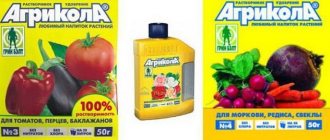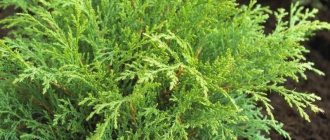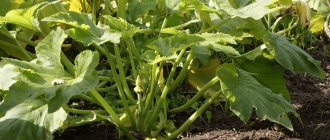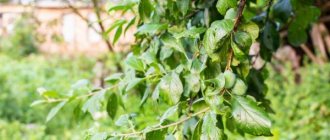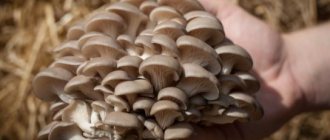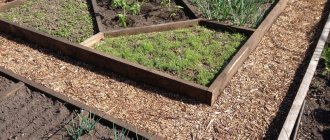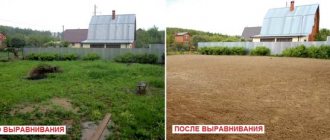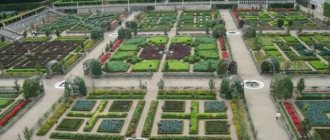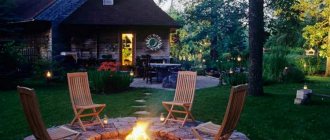Organic farming in the country
Many residents of FORUMHOUSE are the most ardent supporters of the organic farming method, in which the cultivation of fruits occurs in complete harmony with nature, according to the principle “not to remake nature, but to help it.” Strict followers of this method do not use a shovel or hoe, do not remove weeds, and work for several days during the season - the rest of the time they harvest.
Basic principles of organic farming. Supporters of organic farming:
- do not plow or dig up the soil; the maximum that is allowed is to loosen the soil with a Fokin flat cutter to a depth of 5-7 cm.
- never use herbicides. Good agricultural technology is the key to a healthy plant, and in the gardens of famous organists there are no aphids, fungal diseases, or the Colorado potato beetle. And if diseases and pests do appear, they are treated with microbial solutions, folk remedies or biological preparations.
- do not use mineral fertilizers: you can only use compost, rotted manure, mulch, warm beds, etc.
- They try to attract as many earthworms as possible to their site and stimulate the work of soil microorganisms.
- Both beds and paths are actively mulched. Agronomist Nikolai Kurdyumov, the author of the “smart garden” system, says that mulching will not get rid of weeds completely, but it is easier to “pluck one weed exhausted by the struggle for rooting” than to be on duty with a hoe all the time. But the main purpose of mulch is not even to fight weeds, but to maintain moisture, increase soil fertility and improve its structure.
Adhering to these principles on his site, the summer resident pursues three goals:
- increase soil fertility (every year it gets better and better);
- grow extremely healthy and tasty fruits without any chemicals;
- reduce the time spent working in the beds and make work easier.
Asemenich Member of FORUMHOUSE
But health care on the farm requires exceptional consistency and high technological discipline! And without this it’s better not to start...
Where to begin
To begin the transition from the classical method to growing plants according to the principles of organic farming in your garden plot, you need to study this technology. It is important to decide whether the gardener is ready to accept such a philosophy of working with the land, or whether he strongly doubts its effectiveness.
If in doubt, you can select a small area for testing to understand how it all works in practice.
That is, carry out one or two seasons of agricultural work using natural methods: stop digging, cover the ground with mulch, plant green manure, refuse to use chemicals or reduce their amount by at least half. Then all that remains is to compare the results and draw conclusions.
Permaculture by Sepp Holzer
Permaculture is a trend in organic farming, which was founded by the famous Austrian naturalist Sepp Holzer along with two friends.
Permaculturologists set themselves the task of creating a vegetable garden that will take care of itself. To do this, they select plants that stimulate each other's growth, do not compete for nutrients in the soil, and repel pests from each other.
Artecology FORUMHOUSE Member
The art of the lazy owner! This is how I would characterize the concept of permaculture as it applies to all of us.
A member of our portal with the nickname ShadeXXX, using the principles of permaculture, is trying to revive his plot in the steppes of Kazakhstan. Now there is nothing living on his clay plot except dry, stunted grass and mosquitoes, but he is confident that in a few years there will be a garden and a pond.
General concepts
Discussions about how effective and safe this direction in agriculture are continue to this day. However, despite the controversy, the fact remains - the earth is like a sponge that absorbs everything . And the yield in the cultivated area directly depends on how saturated it is with useful microorganisms and substances.
Today, to obtain a bountiful harvest, many people use chemical fertilizers, which negatively affect not only the soil, but also the quality of the crop. Many gardeners have decided to abandon the use of agrochemicals in favor of organic farming.
In simple and accessible language, organic farming is the use of natural processes, waste products, phenomena and living organisms that contribute to the development of natural processes in the agricultural system in order to obtain a healthy, rich and high-quality harvest. With a competent approach, you can get not only high-quality products grown on your own land, but also protect the environment from human intervention.
Bagel's lazy garden
One of the most famous permaculturists in the post-Soviet space is Boris Bublik. He believes that any work with a hoe or shovel is harmful to the garden: you just need not to disturb nature, or even better, help it by planting suitable plants nearby.
He does not remove weeds, works in the garden only a few days a season, and practically does not care for it. The vegetable garden grows according to the “edible forest” principle, on its own, without human intervention. The photo shows Boris Bublik's vegetable garden.
This is a rather radical approach, and among FORUMHOUSE supporters of organic farming the attitude towards Bublik is ambiguous: “he is more of an orator than a scientist.” But this prevents the participants of our portal from successfully using many of the techniques of a permaculturologist. Especially garden tools of his invention (or based on them).
A tool for planting potatoes, or, as the permaculturist himself calls it, a “potato horseradish” is a thick cutting with a nail driven into it to control the depth of the hole. Bublik plants not whole potatoes, but eyes from the largest tubers.
The photo below shows a “potato horseradish” made by a member of our portal with the nickname Deppert.
Deppert
I planted the cut out eyes, poked the holes more tightly, threw the sprouted eyes into the holes and stomped them down. All. Planting 4 varieties of potatoes took about an hour of leisurely work with breaks.
Bublik does not sow seeds into the beds in even rows; he considers this pointless. He has about ten portable seeders - one and a half liter plastic bottles with holes in the bottoms. In each seeder there are holes of certain sizes - very small for carrots, larger ones for beets, etc. The gardener randomly scatters seeds over the beds with a seeder, covers them with soil with a rake or a flat cutter - that’s all.
A summer resident should not stand over the garden bed, bent over like a “g,” says Bublik. He sows large seeds through a long pipe, first making holes with a peg (in the photo this pipe is on the far right).
Another know-how: self-seeding beds. Onions and garlic are not completely harvested in August, the seeds scatter, and in the spring the summer resident, without lifting a finger, has a seeded bed!
Bublik’s book “Your garden. An unusual approach to familiar things” became a primer on organic farming for our participant with the nickname Sly Fox. Thanks to this book, the forum member stopped perceiving the dacha as a place of hard labor and shared useful information with all forum members.
Sly Fox
My main task during the “garden” period was to escape from the dacha rent by any means possible. I read it, and I was hooked, so much so that every day, month, year it becomes more and more difficult to get me out of the vegetable garden.
Narrow beds according to Mittlider
Jacob Mittlider - Doctor of Agricultural Sciences. The goal of his system is to get outstanding yields from a small garden without much difficulty. The system is based on two pillars:
- Narrow ridges and wide passages between them. We talked in detail about this technology, which provides plants with optimal lighting. The beds and passages never change places.
Michurinets FORUMHOUSE Member
I welcome wide passages in this method: we are always crowded, one bed climbs onto another, and when it grows, a jungle is formed.
- Regular feeding of plants with mineral fertilizers. Mittlider makes balanced fertilizers according to special recipes, and they contain a fairly significant amount of mineral fertilizers. The soil can even be replaced with a neutral substrate to which nutrients are added. The main thing is that plants receive deficient magnesium and molybdenum, which convert nitrates into proteins and amino acids necessary for plant growth and maturation.
But this system was developed by the doctor for the most unsuitable soils: barren, polluted, “killed” by construction work, rocky and even artificial soils. The amount of mineral fertilizers that Mittleider offers inevitably leads to soil degradation and salinization.
Therefore, our forum members are skeptical about this part of the system, and adapt Mittlider to their organic principles.
Nadenka
I used this method for several years, now I have left only narrow beds. A lot of fertilizers greatly deplete the soil. Not only have I stopped having weeds, but also worms!
Let's sum it up
The gardeners of our portal rarely follow any one system; rather, they creatively rethink each one and take something useful for themselves. A smart approach to garden beds completely changes country life: drip irrigation, mulching, narrow beds, planting potatoes under hay, etc. lead to the fact that work in the garden ceases to be hard. There is more and more creativity, creation and joy from cooperation with nature.
At FORUMHOUSE you can learn about the double-digging method and John Jevson’s basic recipes for microbial compositions, read an article about autumn digging of soil, and learn how to test soil fertility at home. Get to know our users' organic farming experiences. Follow the permaculture experiment in the steppes of Kazakhstan - soon this dry and hard, like concrete, land will be unrecognizable. Watch our video to help you decide on the type of soil on your site.
Subscribe to our Telegram channel Exclusive posts every week
Practice
If a gardener decides to learn the basics of natural farming, he must understand that starting from scratch will not immediately achieve amazing success. The earth must restore its strength, so tangible results will be visible in the second year of using organic agricultural technology. It is also important to remember that using only one of the methods will not lead to the desired result. You can stop digging, but if you do not mulch the soil, treat the plants with chemicals and do not comply with crop rotation requirements, active positive changes will not occur. What does a farmer gain when he begins to maintain his garden in new ways and means:
- Labor costs for sowing and planting plants, weeding and loosening are reduced, while saving time and effort is significant.
- Water consumption is reduced, watering is required less frequently and is not as abundant as with classical agricultural technology.
- Plants get sick less, grow stronger, and increase productivity, so smaller quantities can be planted.
- The composition of the soil improves, and even heavy clay soils become easier to cultivate.


